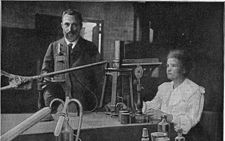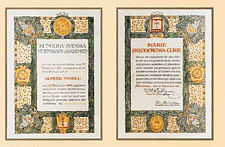Marie Curie
2008/9 Schools Wikipedia Selection. Related subjects: Chemists; Human Scientists
| Marie Curie (neé Skłodowska) | |
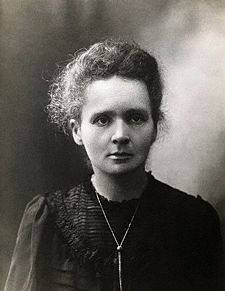 Maria Skłodowska-Curie.
|
|
| Born | November 7, 1867 Warsaw, Congress Poland |
|---|---|
| Died | July 4, 1934 (aged 66) Sancellemoz, France |
| Nationality | Polish, French |
| Fields | Physicist and Chemist |
| Institutions | University of Paris |
| Alma mater | University of Paris and ESPCI |
| Doctoral advisor | Henri Becquerel |
| Doctoral students | André-Louis Debierne Marguerite Catherine Perey |
| Known for | Radioactivity |
| Notable awards | Image:Nobel Prize.png Nobel Prize in Physics (1903) Image:Nobel Prize.png Nobel Prize in Chemistry (1911) |
|
Notes
The only person to win two Nobel Prizes in different science fields. Married Pierre Curie (1895); their children were Irène Joliot-Curie and Ève Curie. |
|
Marie Curie (born Maria Skłodowska; November 7, 1867 – July 4, 1934) was a physicist and chemist of Polish upbringing and, subsequently, French citizenship. She was a pioneer in the field of radioactivity, the first twice-honored Nobel laureate (and still the only one in two different sciences) and the first female professor at the University of Paris.
She was born in Warsaw, Congress Poland, Russian Empire, and lived there until she was 24. In 1891 she followed her elder sister to study in Paris, where she obtained her higher degrees and conducted her scientific work. She founded the Curie Institutes in Paris and Warsaw. She was the wife of fellow-Nobel-laureate Pierre Curie and the mother of a third Nobel laureate, Irène Joliot-Curie.
While an actively loyal French citizen, she never lost her sense of Polish identity. Madame Curie named the first new chemical element that she discovered polonium for her native country.
Life
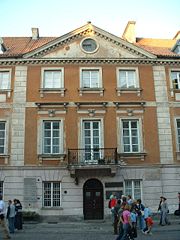
Maria Skłodowska was born in Warsaw to Polish parents, Bronisława and Władysław Skłodowski, both of whom were teachers and instilled in their children a sense of the value of learning. Władysław Skłodowski was a teacher of mathematics and physics.
Maria was the youngest of five children: Zofia (born 1862), Józef (1863), Bronisława (1865), Helena (1866) and finally Maria (1867).
Maria's early years were marked by the death of her sister Zofia (from typhus) and, two years later, the death of her mother (tuberculosis). These events caused her to give up her Roman Catholic religion and become an agnostic.
From childhood Skłodowska showed an exceptional memory and work ethic, and was known to neglect food and sleep in order to study. At age sixteen she graduated from a Russian liceum at the top of her class, winning a gold medal on completion of her secondary education there.
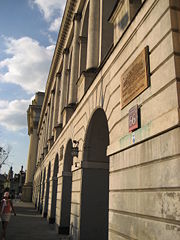
Because she was female, and because of Russian reprisals following the Polish 1863 uprising against Tsarist Russia, Skłodowska was denied admission to a regular university. Her father having lost his savings through bad investments, Maria had to take work as a teacher while attending Warsaw's illegal Polish Floating University. At age 18 she took a post as a governess, where she experienced an unhappy love affair. From her earnings she supported her elder sister Bronisława, who was studying medicine in Paris, on the understanding that Bronisława would in turn later help Maria get an education. Eventually in 1891 Maria went to join her sister in Paris.
At the University of Paris, Skłodowska studied mathematics, physics and chemistry. (Later, in 1909, she would become that University's first female professor, when she was named to her late husband's chair in physics, which he had held for only a year and a half before his tragic death.) In early 1893 she graduated first in her undergraduate class. A year later, also at the University of Paris, she obtained her master's degree in mathematics. In 1903, under the supervision of Henri Becquerel, she received her DSc from the University of Paris, becoming the first woman in France to complete a doctorate.
At the University of Paris, also, she met and married Pierre Curie. At the time, Pierre Curie was an instructor in the School of Physics and Chemistry, the École Supérieure de Physique et de Chimie Industrielles de la Ville de Paris (ESPCI). Skłodowska was a student at the University of Paris, and had begun her scientific career in Paris with an investigation of the magnetic properties of various steels; it was their mutual interest in magnetism that drew Skłodowska and Curie together.
Eventually they studied radioactive materials, particularly pitchblende, the ore from which uranium was extracted. By April 1898, Skłodowska-Curie deduced that pitchblende must contain traces of an unknown substance far more radioactive than uranium. In July 1898, Pierre and Marie together published an article announcing the existence of an element which they named polonium, in honour of her native Poland, then still partitioned among three empires. On December 26, 1898, the Curies announced the existence of a second element, which they named radium for its intense radioactivity — a word that they coined.
Over the course of several years of unceasing work in the most difficult physical conditions, they processed several tons of pitchblende, progressively concentrating the radioactive substances and eventually isolating the chloride salts (refining radium chloride on April 20, 1902). Polonium was not yet isolated at this time.
In 1903, the Royal Swedish Academy of Sciences awarded Pierre Curie, Marie Curie, and Henri Becquerel the Nobel Prize in Physics, "in recognition of the extraordinary services they have rendered by their joint researches on the radiation phenomena discovered by Professor Henri Becquerel."
Curie was the first woman to be awarded a Nobel Prize. Eight years later, she received the 1911 Nobel Prize in Chemistry, "in recognition of her services to the advancement of chemistry by the discovery of the elements radium and polonium, by the isolation of radium and the study of the nature and compounds of this remarkable element".
In an unusual decision, Skłodowska-Curie intentionally refrained from patenting the radium-isolation process so that the scientific community could do research unhindered.
A month after accepting her 1911 Nobel Prize, she was hospitalized with depression and a kidney ailment.
Skłodowska-Curie was the first person to win or share two Nobel Prizes. She is one of only two people who have been awarded a Nobel Prize in two different fields, the other being Linus Pauling (Chemistry, Peace). She remains the only woman to have won two Nobel Prizes, and the only person to have won Nobel Prizes in two different science fields. Nevertheless, the French Academy of Sciences refused to abandon its prejudice against women, and she failed by one vote to be elected to membership. (Pierre had been elected to the Academy in 1905.)
On April 19, 1906, Pierre was killed in a street accident as he was leaving a publisher's office. He had gone there to review proofs of an article, and found the business closed due to a strike. Heading back across the street in heavy rain, he was struck by a horse-drawn vehicle and fell under its wheels, fracturing his skull. While it has been speculated that he may previously have been weakened by prolonged radiation exposure, it has not been proven that this was the cause of the accident. Marie was devastated by her husband's death.
She may subsequently have had an affair with physicist Paul Langevin — a married man who had left his wife — which resulted in a press scandal, exploited by her academic opponents. Despite her fame as a scientist working for France, the public's attitude to the scandal tended toward xenophobia.
Langevin's grandson Michel Langevin later married Skłodowska-Curie's granddaughter, Hélène Joliot.
During World War I, Skłodowska-Curie pushed for the use of mobile radiography units, which came to be popularly known as petites Curies ("Little Curies"), for the treatment of wounded soldiers. These units were powered using tubes of radium emanation, a colorless, radioactive gas given off by radium, later identified as radon. Skłodowska-Curie personally provided the tubes, derived from the radium she purified. Also, promptly after the war started, she donated her and her husband's gold Nobel Prize medals for the war effort.
After World War I, in 1921 and again in 1929, Skłodowska-Curie toured the United States, where she was welcomed triumphantly, to raise funds for research on radium. These distractions from her scientific labors, and the attendant publicity, caused her much discomfort but provided resources for her work. Her second American tour succeeded in equipping the Warsaw Radium Institute, founded in 1925, with her sister Bronisława as director.
In her later years, Skłodowska-Curie headed the Pasteur Institute and a radioactivity laboratory created for her by the University of Paris.

Her death near Sallanches, Savoy, in 1934 was from aplastic anaemia, almost certainly due to exposure to radiation, as the damaging effects of ionising radiation were not yet known, and much of her work had been carried out in a shed with no safety measures. She had carried test tubes containing radioactive isotopes in her pocket and stored them in her desk drawer, remarking on the pretty blue-green light the substances gave off in the dark.
She was interred at the cemetery in Sceaux, where Pierre lay, but sixty years later, in 1995, in honour of their work, the remains of both were transferred to the Panthéon in Paris.
The Curies' elder daughter, Irène Joliot-Curie, won a Nobel Prize for Chemistry in 1935 for discovering that aluminium could be radioactive and emit neutrons when bombarded with alpha rays. The younger daughter, Ève Curie, wrote the biography, Madame Curie, after her mother's death.
Prizes
- Nobel Prize in Physics (1903)
- Davy Medal (1903)
- Matteucci Medal (1904)
- Nobel Prize in Chemistry (1911)
Tribute
As one of the most famous female scientists to date, Marie Curie has been an icon in the scientific world and has inspired many tributes and recognitions. In 1995, she was the first and only woman laid to rest under the famous dome of the Panthéon, in Paris, on her own merits, alongside her husband. The curie (symbol Ci), a unit of radioactivity, is named in their honour, as is the element with atomic number 96 - curium.
Skłodowska-Curie's likeness appeared on the Polish late-1980s inflationary 20,000-złoty banknote. Her likeness also appeared on stamps and coins, and on the last French 500- franc note, with her husband, before the franc was made obsolete by the euro.
Greer Garson and Walter Pidgeon starred in the 1943 U.S. Oscar-nominated film, Madame Curie, based on her life. "Marie Curie" is also the name of a character in a 1988 comedy, Young Einstein, by Yahoo Serious.
Three radioactive minerals are named after the Curies: curite, sklodowskite, and cuprosklodowskite.
Pierre and Marie Curie University, the largest science, technology and medicine university in France, and successor institution to the faculty of science at the University of Paris, where she taught, is named in honour of her and Pierre. The university is home to the laboratory where they discovered radium.
Another school named for her, Marie Curie M.S. 158, in Bayside, New York, specializes in science and technology as does Curie Metropolitan High School, located in the community area of Archer Heights on Chicago's Southwest Side. It has a Technical, Performing Arts and IB program.
In 2007, the Pierre Curie Paris Métro station was renamed the " Pierre et Marie Curie" station.
The Maria Skłodowska-Curie Medallion, a stained-glass panel created by Jozef C. Mazur, may be found at the University at Buffalo Polish Room.
A KLM McDonnell Douglas MD-11 (registration PH-KCC) is named in her honour.
Fiction
- Olov Enquist, Per. The Book about Blanche and Marie. ISBN 1-58567-668-3. a fictionalized account of relationships among Curie, JM Charcot and Blanche Wittman
